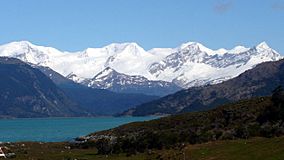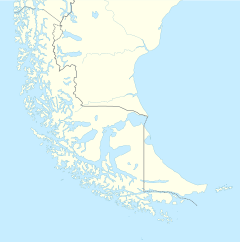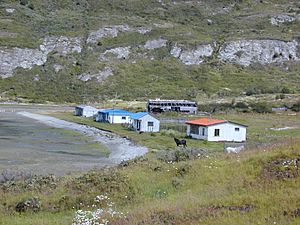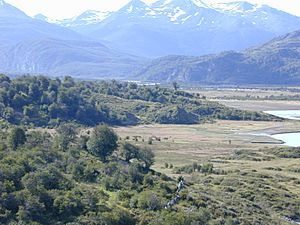Yendegaia National Park facts for kids
Quick facts for kids Yendegaia National Park |
|
|---|---|
|
IUCN Category II (National Park)
|
|

Stoppani Glacier from Yendegaia fjord
|
|
| Location | Tierra del Fuego (main island), Magallanes y la Antártica Chilena Region, Chile |
| Nearest city | Porvenir, Chile |
| Area | 111,832 ha (276,340 acres) |
| Established | December 24, 2013 |
| Governing body | (CONAF) National Forest Corporation (Chile) |
Yendegaia National Park is a special natural area in Tierra del Fuego, Chile. It covers a huge 150,612 ha (372,170 acres) of mountains and unique forests. This park is next to Alberto de Agostini National Park in Chile and Tierra del Fuego National Park in Argentina.
Contents
How Yendegaia National Park Was Created
Yendegaia National Park was created through teamwork. The Government of Chile worked with the Yendegaia Foundation. This foundation was part of a big effort by Douglas and Kris Tompkins to protect nature.
The idea for the park started in 2011. It was one of many projects to celebrate Chile's 200th birthday. The park includes 111,832 ha (276,340 acres) of land owned by the government. It also has 38,780 ha (95,800 acres) from a private farm called Estancia Yendegaia. The Tompkins' foundation gave this land to Chile in 2013 to help create the park.
Because Yendegaia is right next to Argentina's Tierra del Fuego National Park, they form a "Peace Park." This means both countries work together to protect this amazing area.
Exploring Yendegaia's Geography
This park is located south of the Azopardo River. It stretches from the Darwin Range all the way to the border with Argentina. It also goes from the Beagle Channel to Fagnago Lake.
Yendegaia connects two other big parks. It links Chile's Alberto de Agostini National Park with Argentina's Tierra del Fuego National Park. The landscape here is truly amazing. You can find tall mountains, huge glaciers, clear lakes, winding canals, flowing rivers, and deep fjords.
Plants and Animals of Yendegaia
The park protects a very special forest. It's called the sub-Antarctic beech forest. This forest is one of the last big pieces of the ancient supercontinent Gondwana. Gondwana existed about 180 million years ago!
Other trees you can find here include Lenga (Nothofagus pumilio), Canelo (Drimys winteri), and Coigüe (Nothofagus dombeyi).
Yendegaia is a safe home for many animals. Three species that are in danger of disappearing live here. These are the culpeo (a type of fox), the river otter, and the ruddy-headed geese. The park also has 128 different kinds of vascular plants. Plus, there are 49 different types of birds flying around!
Visiting Yendegaia National Park
The Chilean National Forest Corporation (CONAF) manages the park. The closest town in Chile is Porvenir. The Argentinian city of Ushuaia is also nearby.
You can reach the park in a few ways. You can travel by boat from Puerto Williams. Or, you can drive south from Porvenir along the Y-85 road.
Trails and Adventures
Since the park was only created in December 2013, official hiking trails are still being made. But don't worry, there are many unofficial paths to explore! These trails have different difficulty levels. You can start them from the end of the Y-85 road or from Fagnago Lake.
Weather in Yendegaia
The weather here is called a subpolar oceanic climate. This means it can change quickly and often be challenging. Expect lots of rain and cloudy skies.
In winter, from June to September, temperatures can drop very low. It might even get to 11 degrees Celsius below zero! In summer, from December to March, temperatures can sometimes reach 24 degrees Celsius. Always be prepared for different weather when you visit!
More to Explore
- Alberto de Agostini National Park
- Alerce Andino National Park
- Alerce Costero National Park
- Archipiélago de Juan Fernández National Park
See also
 In Spanish: Parque nacional Yendegaia para niños
In Spanish: Parque nacional Yendegaia para niños




